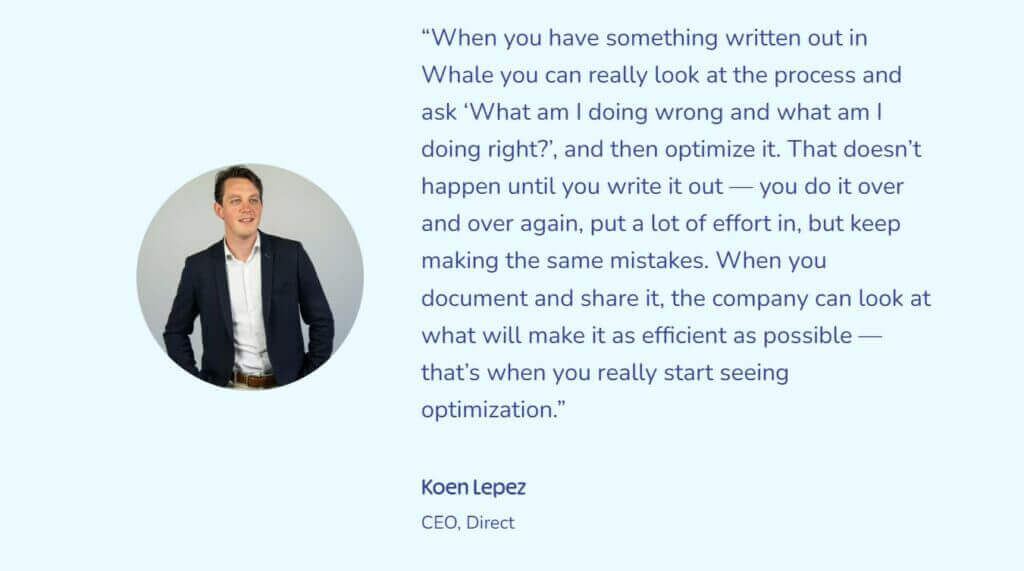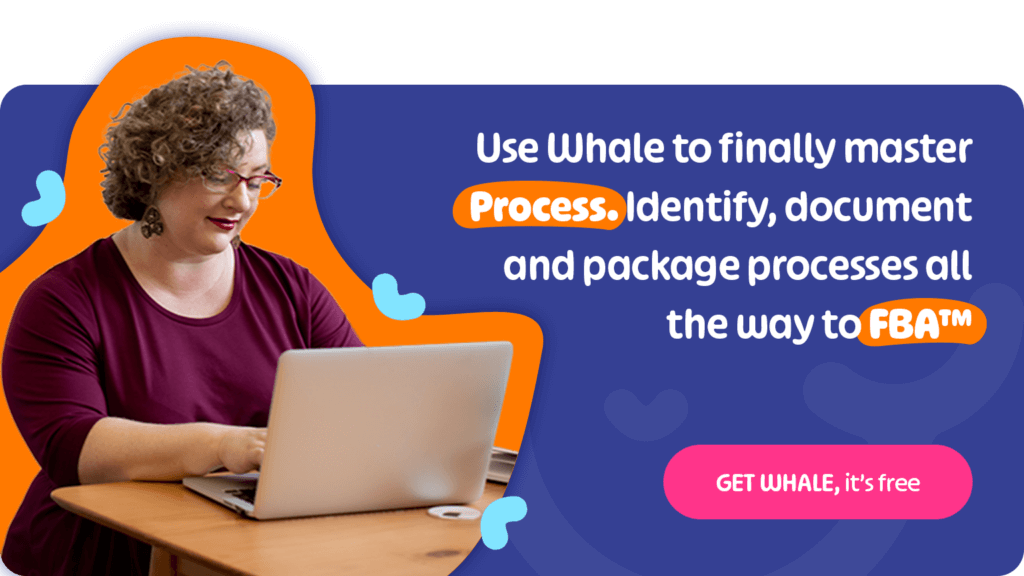Without processes, things get messy.

We built Whale to assist companies get organized. With our process "The Powerful Playbook Process™" we help companies document, train and manage their processes.
Every company has issues. Misalignment, poor communication, and a lack of transparency are the most common issues businesses face.
But when you dig a little deeper, the root cause of these problems is usually the same:
Why process matters?
Absence of process = chaos
Without the clarity processes provide, even the most straightforward daily task can lead to frustration, wasted time, product inconsistencies, and chronic demotivation.
So while the idea of creating and documenting how to create systems for your business may not be the thing that gets you pumped to go to work — your company playbooks and SOPs are the exact things that will make your organization a fantastic place for everyone in it.
Whale works with organizations that run on all kinds of operating systems, but today we’re specifically going to look at how we help companies running on EOS, master process; a crucial piece of the business-scaling puzzle once and for all.
Every business runs on process
Process is the secret sauce to company-wide success.
Because when you break it down, pretty much everything your business touches runs on some process.
And the mastering process is all about identifying, documenting, and scaling the core processes that keep your organization on track to achieve its vision.
When you decide to focus on the process, you’re creating an aligned and consistent workforce that knows the direction they’re pushing in.
Why is process important companies running on EOS ?
The Process Component is one of the Six Key Components™ recommended by the Entrepreneurial Operating System®, the business management system that’s made up of tools and concepts to help ambitious entrepreneurs elevate their businesses.
From employee onboarding to revenue-driving sales SOPs, and even the best ways to host rockstar meetings — it’s all about having an easy process to follow. So, learning to master the Process Component is key!
More often than not, though, we take for granted that the way we do things is the right way. But how many times have you tested that assumption? In many cases, business leaders don’t focus on the process until an unhappy customer or costly employee mistake brings it to their attention.
If that’s you, don’t worry. With these seven tips to process perfection, we’ll have your organization rowing in the same direction in now time.
70% of the time, the root of the issue is in either the People Component™ or the Process Component™.
Source: EOS Worldwide
How to strengthen process in EOS?
Step 1: Double down on documentation
Why?
Comprehensive documentation is the backbone of any efficient process. It ensures that there’s a clear reference point for how tasks should be performed, reducing ambiguity and the likelihood of errors.
For EOS, where clarity and vision are crucial, detailed documentation aligns team members by providing a unified source of truth.
💪🏼 Action Step – Document your prcesses
Though it may sound obvious, you’d be surprised how many organizations don’t get around to documenting their processes. And that’s where the confusion begins.
If your processes are solely in your head, and you pass them on only by word of mouth, you’re playing a potentially costly game of telephone. All it takes is one person to relay a single word incorrectly, and the whole process is broken.
We know what you’re going to say — you have other things to do besides embarking on the mountain climb that is process documentation and avoiding documentation errors.
But pros like Adi Klevit understand just how crucial investing time documenting your processes can be.
"As entrepreneurs, the last thing you want to do is sit down and write procedures — it seems like a mundane, boring task," says Adi. "But you have to be involved in the project. And you have to apply it and maintain it as part of your life, instead of chasing the next shiny object."
It doesn’t have to be difficult. Simply utilize templates 

Step 2: Make your processes easily accessible to all
Why?
Accessibility ensures that every team member can find and understand the processes they’re supposed to follow. This might involve using a centralized platform or repository where documents are stored. In the context of EOS, where every member’s understanding and buy-in are critical for success, ease of access is essential.
💪🏼 Action Step – Share processes with technology
You know which processes you need in place. You have them written down. Yet nothing’s changing.
Why? Because your employees have no idea about all the hard work, you’ve done. And, why’s that? Because you’ve filed them away somewhere, they’d never think to look.
This problem is H-U-G-E.
Studies show that employees spend nearly 20% of their week looking for internal information or tracking down colleagues who can help with specific tasks.
And the cost implications of that are pretty eye-watering. Based on IDC research, losing 2.5 hours per day looking for information could cost a company with 1,000 employees around $25 million every year.
If you’re spending time creating excellent processes to increase your organization’s efficiency, then your teams need to stay up to date.
Processes are there to make employees’ lives simpler. If finding them isn’t intuitive, you’re just adding another layer of searching to their day (and they won’t thank you for it).
Step 3: Scale your processes company-wide
Why?
As a business grows, its processes need to be adaptable and scalable. This means designing processes that can be efficiently rolled out across new teams and departments. In EOS, scalability ensures that the core components—Vision, People, Data, Issues, Process, and Traction—are consistently applied, fostering unity and efficiency as the organization expands.
💪🏼 Action Step – Create more processes
Once you’re in a good rhythm with your SOPs, it’s time to scale it up.
Your core processes are essential. But there’s no reason to stop there. In fact, there’s every reason not to.
Filter process creation down to all levels of your organization. Install them across all departments and functions. And, when you’ve done that, share your processes with external teams who may benefit from understanding how you work too.
Behind every task in the workplace, there’s a process driving success. It’s up to you to find the sweet spot between having too few and too many processes. Strategize scaling — introduce them slowly, month by month, department by department, and in order of priority.
Remember, processes are about minimizing workplace burnout, not increasing it. So scale away, but be mindful of process overload.
With Whale it’s so much easier to ask people to follow these processes time and time again, because it’s not complex. As a manager, asking my team to keep these processes top of mind isn’t adding to their plate. It’s something that actually makes their lives easier and the end result is higher quality."
Megan MayfieldDirector of Business Development, Traction Tools
Step 4: Bring it all together with a rockstar platform ⚡
💪🏼 Action Step – Get the right tool
Okay, so steps 1 to 3 of the Ways to strengthen process are easier said than done. We hear you.
But with a knowledge-sharing platform on hand to do the heavy lifting, you can make process implementation a breeze.
Gone are the days of pen-and-paper processes and uninspiring Word docs. It’s time to go paperless and embrace digital solutions that streamline workflows and enhance efficiency.
With the right software to up your game, you can make documenting, accessing, and sharing processes so simple employees won’t even know they’re following them.
Choosing the proper process tool means knowing what you and your employees need and not settling until you’ve found it. If in doubt, check out our handy guide for some proven tips.
Step 5: Review your processes regularly
Why?
Regular review is critical for continuous improvement. It allows an organization to adapt to changes and refine processes for better efficiency. In EOS, this could tie into the quarterly pulsing, where teams review their Rocks (major priorities), ensuring processes are still aligned with their goals.
💪🏼 Action Step – Schedule automated process reviews
If you’ve followed the previous step and gotten the right software in place, everything from here on out should be miles easier than those first three steps.
Because this one’s all about maintaining a system that already works.
Believe it or not, outdated processes and unnecessary tasks take up 26% of an employee’s day. That’s one hefty time-killer stealing your employee’s attention away from your revenue-generating tasks.
So, why does this happen? The answer is simple, really.
Those processes you created 12 months ago? Yeah, they haven’t been touched since. 
Processes are living documents. As your company grows, your systems develop, and your software advances — and so should your processes. Otherwise, your people will be spending their time on a process that made sense five upgrades ago but has no relevance in the here and now.
At Whale, our platform has two handy features to help with this:
- Assigning process owners: Every process should have someone who owns and is accountable for it. They’re in charge of documenting, scaling, implementing, and revising it.
- Inputting review timelines: When you create a process, set a time to review it — 1 month, 6 months, 12 months, whatever’s necessary based on its importance and likelihood for change. Prioritize business-critical processes, like those you can’t afford to let lag.]
Step 6: Make processes part of your Rocks
Why?
Incorporating process refinement and adherence into your Rocks ensures that these efforts are prioritized and not sidelined. Given that Rocks are meant to be the most critical priorities for the next 90 days, this elevates the importance of processes within the organizational focus.
💪🏼 Action Step – Schedule automated process reviews
You probably already know about the importance of rocks — the top-priority projects to complete within the next 90 days.
Rocks keep the company vision alive by making essential steps towards each quarter’s end goal.
For experts like Adi Klevit, processes have to be on the Rock agenda if you’re going to ace them. "Companies that run on EOS make process a Rock. They choose a process for the quarter, and they make it happen. So when you set a Rock, you actually have to be on track and meet it, and it will be there to discuss every meeting if it doesn’t move forward," she explains.
So if you want to get your processes off the ground, take a top-down approach: ask leadership to prioritize assigning process creation Rocks next quarter and check in on them in their weekly meetings.
Step 7: Make processes fun and exciting
Why?
This is perhaps the most challenging but rewarding strategy. Gamifying process adherence or celebrating milestones in process improvement can foster a culture that values and enjoys continuous improvement. In an EOS framework, where engagement and accountability are key, making processes fun can encourage buy-in and participation from all team members.
💪🏼 Action Step – Think entertainment to make process fun
If there’s one thing business leaders agree on, it’s that getting employee buy-in for process alignment is tough. And often that’s because it’s, well… dull.
We say this with love, but you have to level up to achieve next-level efficiency and keep chasing your vision.
The good news? The right approach to creating your SOPs can make them a lot more fun to look at.
- Switch up your fonts, colors, and structure.
- Use emojis and gifs for ultra-readability.
- Include pictures, videos and voice notes to explain your points better.
While it may not be Disneyland-level exciting, it can be better than words on a screen.
Here’s an example of a fun process we use within our team at Whale.

Bottom line? Nailing process doesn’t have to be hard! 🔨
So there you have it, seven steps to strengthening the process.
Whether it’s costing you money, losing you employees, or preventing you from scaling your company, process can be a big blocker if it isn’t addressed.
While it may seem like a daunting task — especially if you’re in an organization with lots of staff and competing priorities — there are things you can do to make it much easier. And you don’t have to face the challenge alone.

With Whale as your process partner, implementing processes suddenly becomes a real possibility. But don’t just take our word for it.
Here’s how Koen Lopez, CEO of IT services company Direct, sums it up:
"With the help of Whale, we mapped out all of our process boards in one year. And then we went down to the next level, and that’s how Whale allowed us to tackle it: quarter by quarter, month by month, year by year."
Enjoyed this article on ways to strengthen process in your business and want to scale through processes your employees will love?
FAQs about Ways to Strengthen Process in EOS
What are the EOS core processes?
These are the 6-10 Core Business Processes
- HR processes,
- Marketing processes,
- Sales processes,
- Operations processes(how you deliver your product or service),
- Finance processes, and
- Customer Support processes
Click here to access the templates you need to create your core processes.
Why Do Companies Struggle with the EOS Process Component?
The Entrepreneurial Operating System (EOS) is a set of tools and processes designed to help businesses improve and grow by focusing on six key components: Vision, People, Data, Issues, Process, and Traction.
When it comes to the Process Component™, and EOS in general, several challenges often arise, leading companies to struggle with its implementation.
This includes;
- Lack of Standardization
- Resistance to change
- Overcomplication
- Lack of consistency
- Inadequate training
- Failure to align processes with the company vision
- Inconsistent review
How do you get your processes followed by all (FBA) in EOS?
In addition to the above, to ensure that your processes are followed by all (FBA) within the Entrepreneurial Operating System (EOS), you can implement the following strategies:
- Training and Onboarding: Incorporate process training into your onboarding program for new hires across all business units. Offer regular training sessions and workshops to ensure that current employees are up to date on any changes or updates to the processes.
- Leadership Buy-in and Modeling: Secure the support of leaders and managers, as their endorsement is crucial for team adherence. Leaders should model the behavior by following the processes themselves, demonstrating their importance and commitment.
- Integration and Technology Use: Seamlessly integrate the processes into daily workflows, utilizing technology to automate steps where possible. This makes adherence simpler and more efficient, reducing resistance.
- Feedback Loops and Regular Reviews: Establish regular review sessions for evaluating process efficiency and effectiveness, incorporating feedback from employees. This not only optimizes processes but also fosters a sense of ownership and engagement among team members.
- Accountability and Recognition: Set clear accountability measures with specific metrics or goals related to process adherence, recognizing and rewarding teams or individuals who comply. This encourages motivation and continuous improvement.






